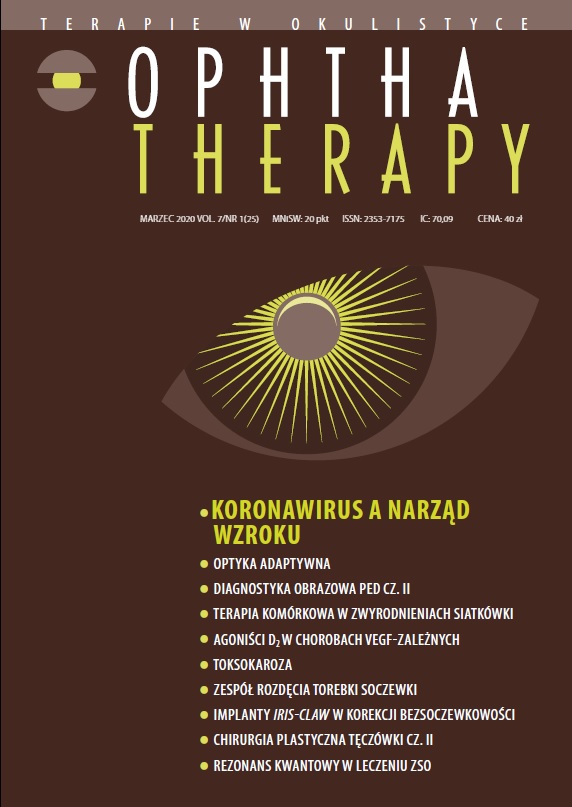Capsular bag distension syndrome: an uncommon complication following cataract surgery Review article
Main Article Content
Abstract
Capsular bag distension syndrome is an uncommon complication following cataract extraction, which may occur even several years after surgery. The main symptoms include a gradual or sudden development of myopia and – in cases with opaque intracapsular fluid – a decrease in visual acuity. Anterior segment-optical coherence tomography is useful in confirming the diagnosis, however, Scheimpflug imaging or ultrasound biomicroscopy can also be considered. Nd:YAG posterior (or anterior) capsulotomy is an established treatment method. An advantage of surgical treatment is the feasibility of removing the intracapsular fluid completely. This article presents the modern classification, diagnostic methods and principles of management in the capsular bag distension syndrome.
Downloads
Article Details

This work is licensed under a Creative Commons Attribution-NonCommercial-NoDerivatives 4.0 International License.
Copyright: © Medical Education sp. z o.o. License allowing third parties to copy and redistribute the material in any medium or format and to remix, transform, and build upon the material, provided the original work is properly cited and states its license.
Address reprint requests to: Medical Education, Marcin Kuźma (marcin.kuzma@mededu.pl)
References
2. Huerva V, Sánchez MC, Ascaso FJ. Late postoperative capsular block syndrome: a case series studied before and after Nd:YAG laser posterior capsulotomy. Eur J Ophthalmol. 2015; 25: 27-32.
3. Miyake K, Ota I, Miyake S et al. Liquefied aftercataract: a complication of continuous curvilinear capsulorhexis and intraocular lens implantation in the lens capsule. Am J Ophthalmol. 1998; 125: 429-35.
4. Roberts TV, Sutton G, Lawless MA et al. Capsular block syndrome associated with femtosecond laser–assisted cataract surgery. J Cataract Refr Surg. 2011; 37: 2068-70. https://doi.org/10.1016/j.jcrs.2011.09.003.
5. Zacharias J. Early postoperative capsular block syndrome related to saccadic-eye-movement-induced fluid flow into the capsular bag. J Cataract Refract Surg. 2000; 26: 415-9.
6. Neri A, Pieri M, Olcelli F et al. Swept-source anterior segment optical coherence tomography in late-onset capsular block syndrome: high-resolution imaging and morphometric modifications after posterior capsulotomy. J Cataract Refract Surg. 2013; 39: 1722-8.
7. Kim HK, Shin JP. Capsular block syndrome after cataract surgery: clinical analysis and classification. J Cataract Refract Surg. 2008; 34: 357-63.
8. Vlasenko A, Malyugin B, Verzin A et al. Capsular bag distention syndrome: case series and management strategies. Lisbon 2017.
9. Sorenson AL, Holladay JT, Kim T, et al. Ultrasonographic measurement of induced myopia associated with capsular bag distention syndrome. Ophthalmology. 2000; 107: 902-8. https://doi.org/10.1016/s0161-6420(00)00020-8.
10. Yang MK, Wee WR, Kwon JW et al. Anterior chamber depth and refractive change in late postoperative capsular bag distension syndrome: a retrospective analysis. PLoS One. 2015; 10: e0125895.
11. Holtz SJ, Jerome Holtz S. Postoperative capsular bag distension. J Cataract Refract Surg. 1992; 18: 310-7. https://doi.org/10.1016/s0886-3350(13)80910-8.
12. Jain AK, Sukhija J, Saini JS. Surgical management of early postoperative capsular bag distension syndrome. J Cataract Refract Surg. 2004; 30: 1143-5.
13. Ghanem VC, Ghanem EA. Sudden decrease in vision caused by liquefied after-cataract. J Cataract Refract Surg. 2003; 29: 210-2.
14. Zhu XJ, Zhang KK, Yang J et al. Scheimpflug imaging of ultra-late postoperative capsular block syndrome. Eye. 2014; 28: 900-4.
15. Kucukevcilioglu M, Hurmeric V, Erdurman FC et al. Imaging late capsular block syndrome: Ultrasound biomicroscopy versus Scheimpflug camera. J Cataract Refract Surg. 2011; 37: 2071-4. https://doi.org/10.1016/j.jcrs.2011.08.023.
16. Wang X, Dong J, Zhang S, Sun B. OCT Application Before and After Cataract Surgery. In: Lanza M (ed). OCT Application in Ophthalmology. IntechOpen Limited, London 2018; 175-89.
17. Tak H. Hydroimplantation: Foldable intraocular lens implantation without an ophthalmic viscosurgical device. J Cataract Refract Surg. 2010; 36: 377-9. https://doi.org/10.1016/j.jcrs.2009.10.042.
18. Miyake K, Ota I, Ichihashi S et al. New classification of capsular block syndrome. J Cataract Refract Surg. 1998; 24: 1230-4.
19. Kitagawa K, Hayasaka S, Nagaki Y. Increased aqueous flare intensity in eyes with liquefied after-cataract. J Cataract Refract Surg. 2004; 30: 1342-4.
20. Dhaliwal DK. Late capsular block syndrome associated with Propionibacterium acnes. Arch Ophthalmol. 2011; 129: 246. https://doi.org/10.1001/archophthalmol.2010.356.
21. Perry A, Lambert P. Propionibacterium acnes: infection beyond the skin. Expert Rev Anti Infect Ther. 2011; 9: 1149-56.
22. Hawlina G, Drnovšek-Olup B, Možina J et al. Photodisruption of a thin membrane near a solid boundary: an in vitro study of laser capsulotomy. Applied Physics A. 2016; 122. https://doi.org/10.1007/s00339-016-9648-z.
23. Titiyal JS, Falera R, Kaur M et al. Management of late-onset flocculent after-cataract with capsular bag lavage and posterior continuous curvilinear capsulorhexis. Indian J Ophthalmol. 2018; 66: 984-7.

